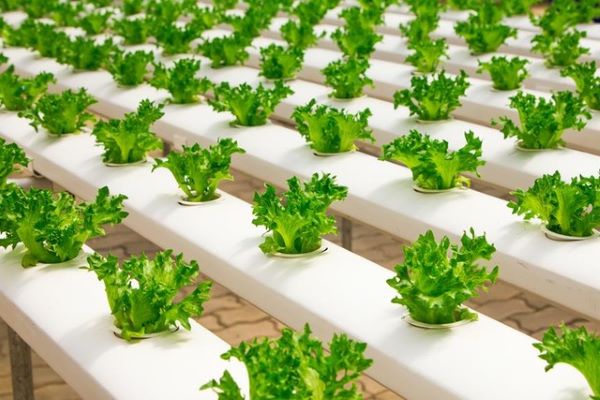Did you know that you can grow lettuce without soil?
In this article we delve into the innovative method of hydroponics, which allows for faster growth and higher yields compared to traditional gardening.
This step-by-step guide provides instructions on germinating lettuce seeds, transplanting seedlings into a hydroponic system, and caring for hydroponic lettuce.
Discover how this sustainable and water-efficient technique can transform your garden and provide you with an abundance of fresh, nutritious lettuce.
Choosing the Right Hydroponic System
When selecting the appropriate hydroponic system, consider the specific needs of your lettuce plants. Innovation in hydroponics has led to a variety of systems that cater to different growing preferences.
One option is the nutrient film technique (NFT), which involves a thin film of nutrient-rich water flowing over the roots of the plants. This system provides continuous access to water and nutrients while promoting oxygenation of the roots.
Another innovative choice is the deep water culture (DWC) system, where the roots are submerged in a nutrient solution. This method maximizes water and nutrient uptake, resulting in rapid growth and high yields.
Aeroponics is also worth considering, as it involves suspending the roots in a mist of nutrient solution, providing optimal oxygenation.
Selecting the Ideal Lettuce Varieties
Which lettuce varieties are ideal for hydroponic gardening?
When it comes to selecting the perfect lettuce varieties for your hydroponic garden, there are a few options that stand out for their adaptability and high yields. Consider these choices:
- Crisphead Lettuce:
- Crisp and crunchy texture
- Excellent for salads and sandwiches
- Varieties like ‘Iceberg’ and ‘Great Lakes’ are popular choices
- Leaf Lettuce:
- Tender and flavorful leaves
- Perfect for mixed greens and wraps
- Varieties like ‘Salad Bowl’ and ‘Red Sails’ offer vibrant colors and delicious taste
Mastering Seed Germination Techniques
To achieve successful seed germination in hydroponic lettuce, utilize effective techniques for maximizing growth and yield.
Begin by selecting a suitable growing medium such as rockwool, lightweight clay aggregate, coconut fiber, or perlite.
Fill trays with a moist growing medium and sprinkle up to three seeds in each plug, covering them with a quarter-inch of medium. Regularly mist the seeds to keep the growing medium moist.
Once the seedlings have mature leaves and roots, gently transplant them into the hydroponic system. Be careful not to damage the roots during transplantation.
Ensure that the roots dangle into the nutrient solution below.
Optimizing Nutrient Levels for Maximum Growth
To optimize the growth of hydroponic lettuce, it is crucial to carefully regulate and maintain the nutrient levels in the system. This can be achieved by following these key steps:
- Monitor the nutrient solution regularly: Ensuring that the nutrient solution is properly balanced is essential for maximum growth. Regularly check the pH levels and adjust as needed to maintain an optimal range for lettuce growth.
- Provide the right balance of macronutrients: Lettuce requires a higher amount of nitrogen for leaf growth and phosphorus for maturity and increased yield. Adjust the nutrient solution accordingly to provide these essential macronutrients in the correct proportions.
Implementing Effective Care and Maintenance Practices
Continuing to optimize the growth of hydroponic lettuce is crucial for ensuring robust and healthy plants. Implementing effective care and maintenance practices is key to achieving this goal.
To provide the right conditions for the plants, it is important to maintain adequate light, air temperature, and nutrient levels.
To promote optimal growth, providing 10 to 14 hours of moderate to low light each day is recommended. This will ensure that the plants receive sufficient light for photosynthesis.
Regularly checking the nutrient solution is also important. This helps to identify signs of evaporation and allows for supplementation accordingly. By ensuring that the plants receive the necessary nutrients, their growth and development will be supported.
In addition, maintaining a cool air temperature is crucial. Keeping the air temperature below 75 degrees Fahrenheit is recommended. During the day, temperatures between 68 and 75 degrees Fahrenheit are ideal. Night temperatures should be slightly lower. This temperature range provides an optimal environment for the plants to thrive.
Conclusion
In conclusion, hydroponic gardening offers a revolutionary way to cultivate lettuce and other plants without soil. By implementing the right hydroponic system, selecting suitable lettuce varieties, mastering seed germination techniques, optimizing nutrient levels, and implementing effective care and maintenance practices, gardeners can revolutionize their gardens and enjoy bountiful harvests of fresh and nutritious hydroponic lettuce.
Embracing hydroponics allows for sustainable and water-efficient gardening, resulting in faster growth and higher yields.
So, let us embark on this journey of innovation and transformation in our gardens.








